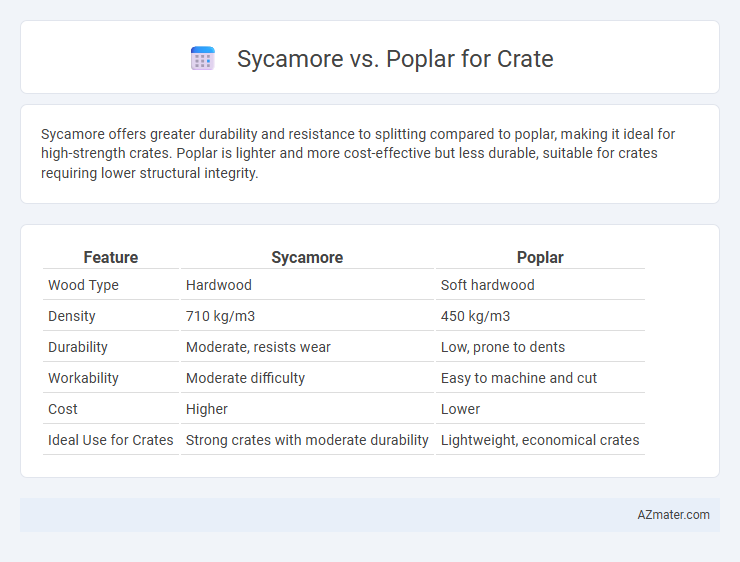Sycamore offers greater durability and resistance to splitting compared to poplar, making it ideal for high-strength crates. Poplar is lighter and more cost-effective but less durable, suitable for crates requiring lower structural integrity.
Table of Comparison
| Feature | Sycamore | Poplar |
|---|---|---|
| Wood Type | Hardwood | Soft hardwood |
| Density | 710 kg/m3 | 450 kg/m3 |
| Durability | Moderate, resists wear | Low, prone to dents |
| Workability | Moderate difficulty | Easy to machine and cut |
| Cost | Higher | Lower |
| Ideal Use for Crates | Strong crates with moderate durability | Lightweight, economical crates |
Introduction to Sycamore and Poplar Wood
Sycamore wood, known for its fine, even texture and interlocking grain, offers durability and a smooth finish, making it ideal for crates requiring strength and aesthetic appeal. Poplar wood is lightweight with a straight grain and uniform texture, valued for its affordability and ease of workability in crate construction. Both woods provide distinct advantages: sycamore delivers robust durability, while poplar excels in cost-effectiveness and ease of handling.
Botanical Overview: Sycamore vs Poplar
Sycamore (Platanus spp.) and Poplar (Populus spp.) are distinct in botanical classification, with Sycamore belonging to the Platanaceae family and Poplar to the Salicaceae family. Sycamore wood is dense and heavy with coarse grain, ideal for crates requiring strength, while Poplar is lighter and softer, offering easier workability but less durability. Both trees grow rapidly, but Sycamore typically develops broader leaves and flaky bark, whereas Poplar features narrow, triangular leaves and smooth bark, influencing their suitability in crate manufacturing based on structural needs.
Appearance and Grain Comparison
Sycamore wood exhibits a fine, uniform texture with a light, creamy color often accented by subtle, wavy grain patterns that add a visually appealing, natural elegance to crates. Poplar features a straighter grain with a more consistent, pale yellow to greenish hue, sometimes showing occasional streaks of darker brown or purple, providing a simpler but clean aesthetic. The more intricate and decorative grain of sycamore enhances the crate's appearance, making it preferable for applications where visual detail is desired over the more utilitarian look of poplar.
Hardness and Durability Differences
Sycamore has a Janka hardness rating of around 1,450 lbf, making it significantly harder and more resistant to dents and scratches compared to poplar, which rates approximately 540 lbf. This increased hardness contributes to sycamore's greater durability for crates that require long-term use and heavier weight handling. Poplar's lower hardness results in softer wood that is more prone to wear but easier to work with, suitable for light-duty or decorative crates.
Workability and Machining Properties
Sycamore wood offers superior workability and machining properties compared to Poplar, making it ideal for detailed crate construction. Its fine, even texture and moderate hardness allow for clean cuts, smooth sanding, and excellent nail and screw holding capacity. Poplar, while lighter and softer, tends to chip more easily and produce rougher finishes, requiring more careful handling during machining.
Weight and Density: Which is Lighter?
Sycamore wood has a density of approximately 700 kg/m3, making it heavier than Poplar, which averages around 560 kg/m3. Due to its lower density, Poplar is lighter and often preferred for crates requiring easier handling and reduced shipping costs. Weight differences between Sycamore and Poplar significantly impact the overall crate design, especially in industries prioritizing lightweight packaging solutions.
Moisture Resistance and Stability
Sycamore wood offers superior moisture resistance compared to poplar, making it less prone to warping and swelling in humid conditions. Poplar tends to absorb moisture more readily, which can compromise crate stability over time, especially in variable environmental settings. For applications requiring durable, moisture-resistant crates, sycamore is generally the preferred choice due to its tighter grain and better dimensional stability.
Cost and Availability for Crate Making
Sycamore wood tends to be more expensive than poplar due to its density and finer grain, making it a less common choice for crate making when budget constraints are present. Poplar is widely available and affordable, making it the preferred option for large-scale or cost-sensitive crate production. Availability of poplar is higher across North America and Europe, resulting in quicker procurement and consistent supply for manufacturing needs.
Environmental Impact and Sustainability
Sycamore wood is a sustainable choice for crates due to its rapid growth rate and widespread availability, minimizing deforestation effects. Poplar also ranks high in environmental sustainability, as it sequesters carbon efficiently and grows quickly on marginal lands, reducing pressure on native forests. Both woods offer eco-friendly options, but sycamore typically has a lower environmental footprint in crate production because of its denser structure and longer durability.
Best Choice: Sycamore or Poplar for Crates
Sycamore wood offers superior strength and durability with a fine, uniform grain making it ideal for crates that require rigidity and longevity. Poplar is lighter and more cost-effective but less robust, suited for lightweight crates or short-term use. For heavy-duty or long-lasting crates, sycamore is the best choice due to its enhanced resistance to wear and impact.

Infographic: Sycamore vs Poplar for Crate
 azmater.com
azmater.com